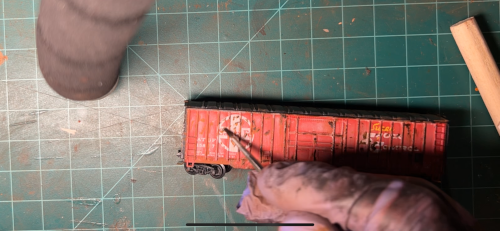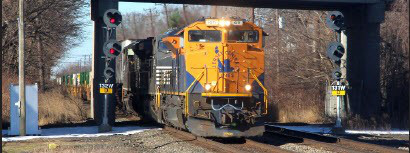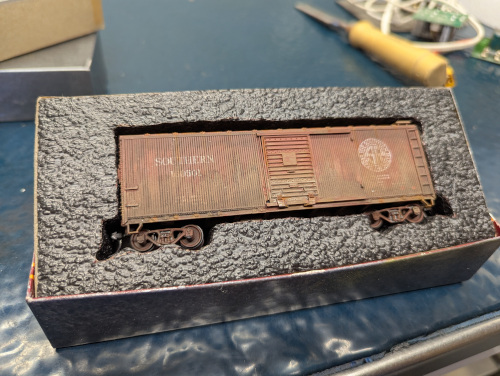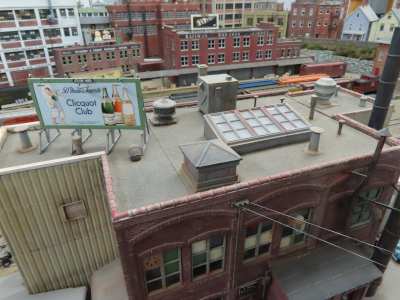Soldering: Tips, Tricks, and Techniques
By: Greg Williams
Time: 6:30 PM EDT on Monday, March 17
Soldering is often viewed with fear and anxiety. When you don't know the how of it, you will struggle to get good solder joints. In this clinic, some basic theory shows what happens when soldering and what makes for a good solder joint. With that knowledge, practical model railroad applications of soldering are shown with a few tips and tricks included from Greg's 45 years of soldering experience.
Weathering
By: Dennis Colucci
Time: 9:00 PM EDT on Monday, March 17
Using a variety of mediums, Dennis Colucci shares the techniques he uses to weather his rolling stock, which are applicable to any steel sided car from G scale all the way down to N or Z! Combining Oil paints, acrylics, and weathering powders, Dennis recreates realistic rust, grime, and paint fading!
Scratchbuilding a Small Rural Station for a Merit Award
By: John McHugh
Time: 6:30 PM EDT on Tuesday, March 18
Are you interested in earning a Merit Award for the Master Builder – Structures certificate? This clinic will illustrate how to scratchbuild a small rural passenger station to specifically earn a Merit Award. John will demonstrate how he focused on the Judging Guidelines used in the Merit evaluation process to construct the building. The entire process is explained and illustrated including finding a prototype building, making drawings, constructing the structure and adding details for judging. The clinic will also offer pointers to maximize points when filling out the Contest Judging Form. This clinic will help you get started on your Structures Certificate.
A Railroad Signaling Primer for Modelers Part 4: Taking a Modular “Approach”
By: Scott Gothe
Time: 9:00 PM EDT on Tuesday, March 18
Historically, railroad signals have been, for many modelers, one of the more challenging “aspects” to incorporate on a layout for a wide variety of reasons. Regardless of size, complexity, era, or level of sophistication desired, there are very few model railroads (or model railroaders) that would not benefit from adding at least some part of this very important operation of the prototype. This clinic continues the series (Parts 1 through 3 covered Signaling Definitions, Basic Fixed and Non-Fixed Signal Operation, and Basic Routing and Interlocking) by taking a look at some of the practical issues faced by Modular Layouts, and introduces the concept of Basic Signal Topology Elements to analyze and create functional signaling networks for both modular and fixed layouts.
Railroads and the Natural Ice Industry: A Symbiotic Relationship
By: Bruce DeYoung
Time: 6:30 PM EDT on Wednesday, March 19
The harvesting of natural ice to preserve food and cool drinks began in the early 1800’s on farms and homesteads. By the middle 1800’s, it became a large industry. Like many other industries involving heavy, bulky commodities, the ice industry turned to the railroads to transport their product. For the next 50 -60 years, the natural ice industry became huge customers of the railroads. At the same time, shipping refrigerated products by rail increased dramatically, and the railroads became huge customers of the ice industry. In this clinic, Bruce will look at the commercial process of harvesting, storing, and shipping natural ice and the role that railroads used in the process.
Making Foam Cradles for Transporting Models
By: Peter Bach
Time: 9:00 PM EDT on Wednesday, March 19
In this clinic, Peter Bach from the Hudson Valley division, will demonstrate how to create foam inserts for safely transporting your scratch-built models. These principles can be applied to any project. Peter will begin by discussing various foam options and provide you with the tools to choose the best option for your project and budget. He’ll also share tips on where to find materials at little to no cost.
Plastic rocks
By: Jeff Gerow
Time: 6:30 PM EDT on Thursday, March 20
When Jeff built his NMRA HO scale module, he knew he wanted mountains but didn't want to have to lift heavy plaster versions of rocks. Jeff discovered Joel Bragdon's method of using hard plastic to model the rock details with a foam backing to make it hardy. His module's mountains are now over 20 years old with no damage and lots of happy viewing. Since the HUB's Museum of Science layout needs a rock face, at this clinic Jeff will demonstrate what's involved in using Bragdon Enterprises 2-part plastic system to make those rocks – a method you could use to model rocks on your own layout.
Building a Layout in a Year - Some Tips and Tricks
By: David Foster
Time: 9:00 PM EDT on Thursday, March 20
Currently in the process of planning, designing and building of Dave's 8th layout this presentation will cover some "common knowledge" topics but hopefully introduce some new tricks accelerating your build process. We'll cover the use of CAD (Computer Aided Design) for your layout and show how to "Avoid" structural modifications during the process. Thinking of using JRMI? We show how using a CAD system you can export the JRMI code into building your layout schematic including signaling. We'll cover ways to reduce your time "Under" the deck with wiring and switch machine mounting. On top of the deck we'll show fast and accurate ways to transfer from design to layout, and some new products to help reduce the landscaping process. The goal of this presentation is to get you to running your trains on your layout in a shorter time period.







